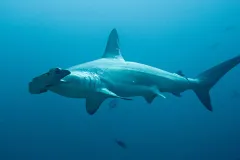Do Sharks Smell in Stereo?

Animals, on land and in the ocean, live in a 3-D world, and they depend on their sense organs and brains to build the mental constructs that allow them to orient and navigate, which is crucial for hunting and fleeing. The process is far from simple. Humans, for example, use many visual clues to judge relative distance. Objects get smaller and blurrier with distance and parallel lines appear to converge, principles that painters mastered in the 13th and 14th centuries in their quest to turn a 2-D canvas into a 3-D experience. More recently, paired cameras have made 3-D photographs and films a reality. The vividness of the experience stems from the fact that our strongest sense of dimensionality comes from our binocular vision--fusing the messages from two optic nerves into one 3-D image.
Many animals in the ocean depend much more on hearing and smell than vision. Like us, they often hear or smell with paired sense organs, so is there an equivalent to binocular vision with ears and noses? A noise coming from the right side is louder in the right ear than the left, which is why we can sense the direction that a sound is coming from. But even more precise information on location and direction comes from subtle differences in the timing of when a sound arrives at each ear. Toothed whales and dolphins depend on their fine-tuned ability to hear in stereo to find their prey.
But what about sharks that hunt by smell rather than sight? Can they smell in stereo? Traditionally it has been assumed that the bloodhounds of the sea compare the intensity of an odor (the equivalent of the loudness of a sound) from different directions and head towards the stronger smell. As logical as this seems, a recent study challenges this conventional understanding and suggests that sharks do indeed "smell in stereo."
Small eddies (or movements of the water) can make the “loudness” of a smell surprisingly inconsistent over short distances, forcing an animal to take the time to confirm first impressions. So the quickest way to know which direction to swim for dinner--which is important when dinner can swim away--comes from paying attention to which nostril smells food first. It should come as no surprise then, that for a hungry shark, timing trumps intensity. Of course the farther apart the nostrils, the easier it is to detect differences in smell arrival times. Hammerhead sharks, with their widely separated nostrils, may be taking advantage of this.
For humans, 3-D movies and TV are all the rage. Can an odorized Avatar be far behind?
Editors Note: This post was co-written with Amanda Feuerstein, program coordinator in the office of the Sant Chair for Marine Science. Dr. Nancy Knowlton is the Sant Chair for Marine Science at Smithsonian’s National Museum of Natural History. Their blog series is based on Dr. Knowlton's book Citizens of the Sea, which celebrates “the Wondrous Creatures from the Census of Marine Life.”

